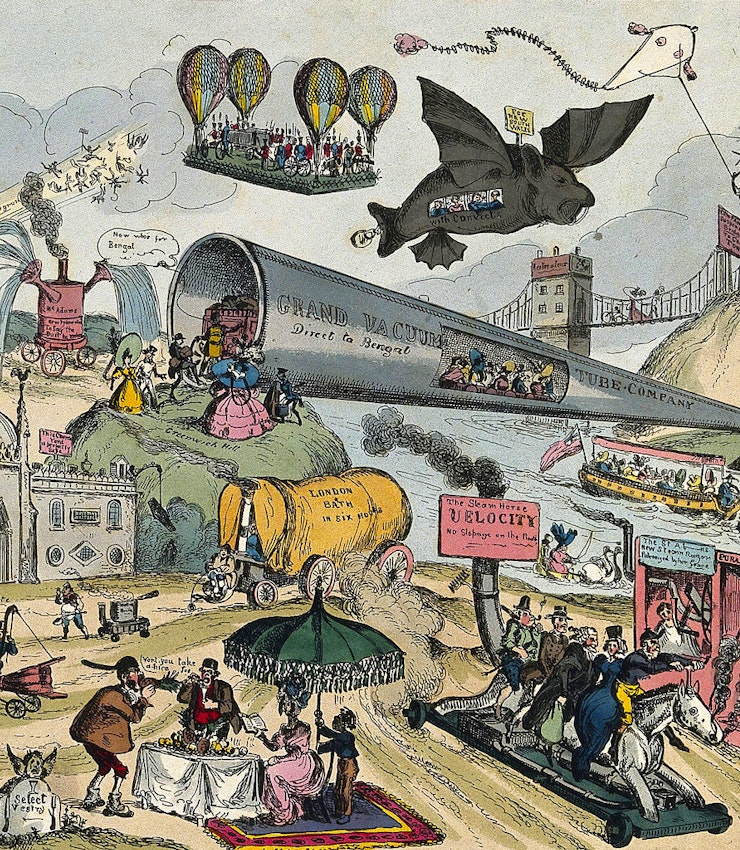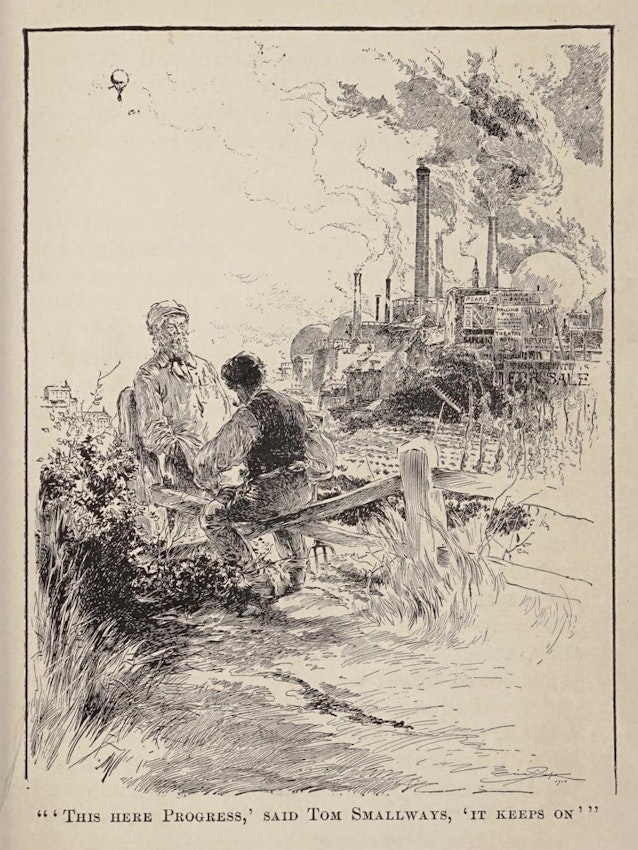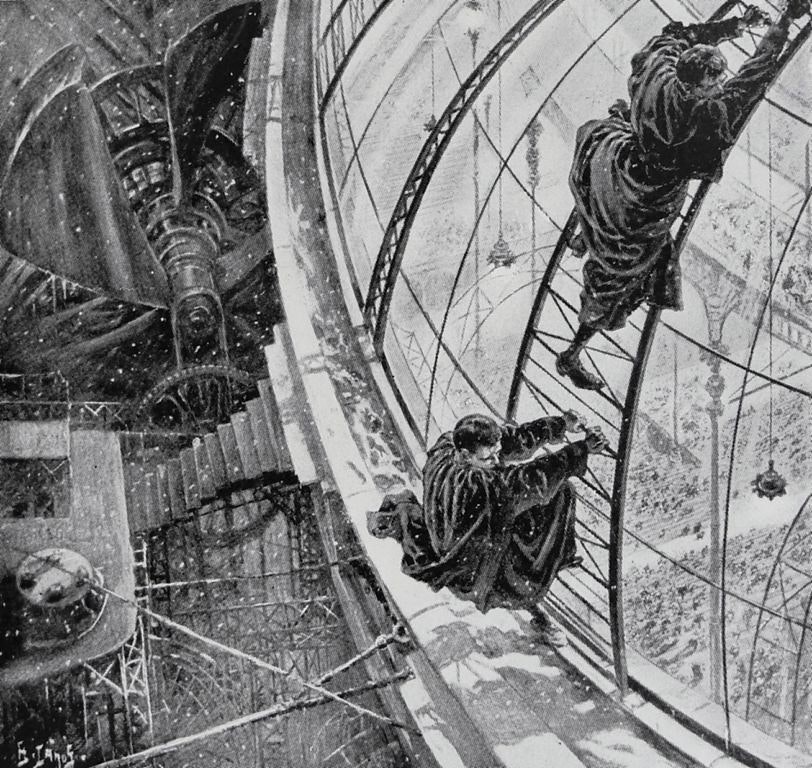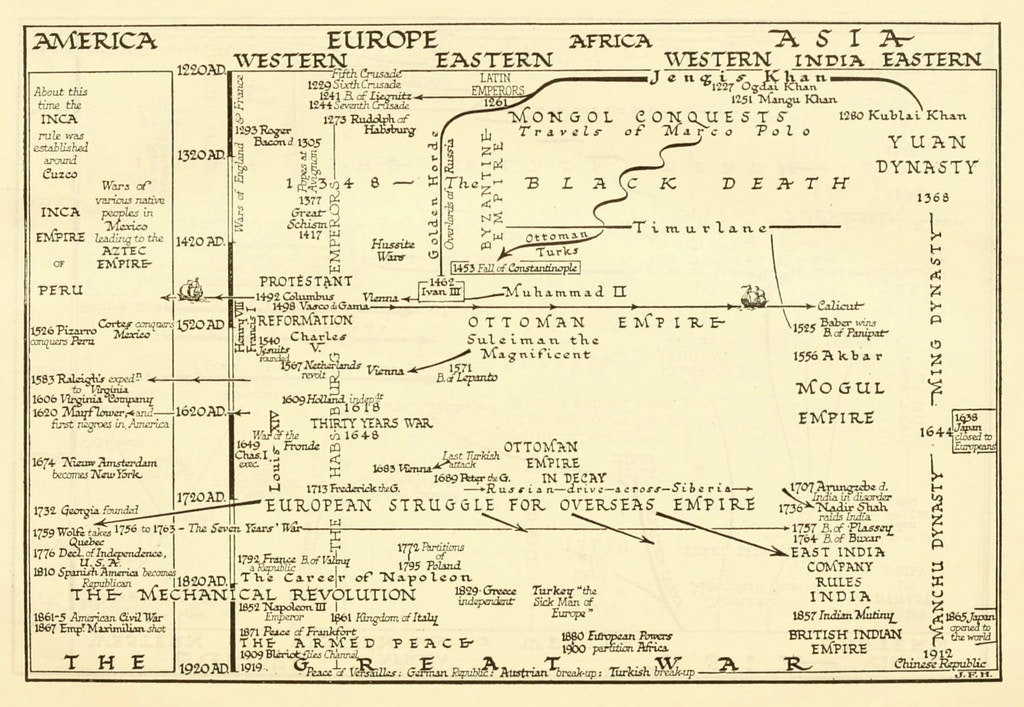
H. G. Wells and the Uncertainties of Progress
In addition to the numerous pioneering works of science fiction by which he made his name, H. G. Wells also published a steady stream of non-fiction meditations, mainly focused on themes salient to his stories: the effects of technology, human folly, and the idea of progress. As Peter J. Bowler explores, for Wells the notion of a better future was riddled with complexities.
June 27, 2019
 Scroll through the whole page to download all images before printing.
Scroll through the whole page to download all images before printing.Detail from March of Intellect (ca. 1828), a satirical cartoon by William Heath, featuring fanciful future applications of contemporary technology, but including the prescient vacuum tube for travel. Across the top of the print (cropped out here) it reads “Lord how this world improves as we grow older” — Source.
H. G. Wells worried constantly about the future of humanity. While he hoped for progress in human affairs, he was only too well aware that it was not inevitable and might not be sustained. Throughout his career he celebrated the technological developments that were revolutionizing life but feared they might lead to eventual degeneration or, as came to pass in 1914, a catastrophic war. He was also aware that there were disagreements over what would actually count as progress. Providing everyone with the benefits of modern industry might not be enough, especially as continued technological innovation would require the constant remodeling of society. Progressive steps introducing entirely new functions were episodic, open-ended and unpredictable, in both biological and social evolution. These uncertainties were compounded by a realization that, where technological innovation was concerned, it was virtually impossible to predict future inventions or what their long-term consequences might be. Even if progress continued, it would be much more open-ended than advocates of the traditional idea of progress had imagined.1
For Wells the most basic level of uncertainty arose from the fear that the human race might not sustain its current rate of development. In his 1895 story “The Time Machine” he imagined his time traveler projected through eras of future progress: “I saw great and splendid architecture rising about me, more massive than any buildings of our time, and yet, as it seemed, built of glimmer and mist.”2 But the time traveler ends up in a world brought down by social division and degeneration. The brutal Morlocks are the descendants of the industrial workers, while the childlike Eloi are the remnants of the leisured upper classes. This prediction was based on his zoologist friend E. Ray Lankester’s extension of the Darwinian theory. Lankester argued that because evolution works by adapting populations to their environment, progress is not inevitable and any species that adapts itself to a less active and hence less challenging way of life will degenerate.3 Here was the model for a more complex vision of progress in which any advance would depend on the circumstances of the time and could not be predicted on the basis of previous trends.
 Scroll through the whole page to download all images before printing.
Scroll through the whole page to download all images before printing.Illustration by Eric Pape from the first American edition of H. G. Wells’ The War in the Air (1908) — Source.
The Darwinian viewpoint is more clearly visible in Wells’ hugely successful non-fiction work The Outline of History, originally published in fortnightly parts in 1920. The survey starts from the development of life on earth and the evolution of the human species. Progress had certainly happened both in evolution and in human history from the Stone Age onward, but Wells shows that there was no predetermined upward trend. His exposure to the Darwinian vision of biological evolution (which continued in his collaboration with Julian Huxley to produce The Science of Life some years later) showed him that there were multiple ways of achieving a more complex biological structure — or a more complex society. Truly progressive steps in both areas were sporadic, unpredictable, and open-ended. When progress did occur in human society, Wells was certain that the driving force was rational thinking, science, and technological innovation. Yet history showed how all too often the benefits of creativity had been undermined by conservatism and social tensions, culminating in the disaster of the Great War.4
Wells was elaborating a new and less deterministic version of the idea of progress. Nineteenth-century society’s faith in the inevitability of progress had been misplaced, not just because it underestimated obstacles, but because it had assumed an oversimplified model of how development must take place. Whatever their differing views of the goal to be achieved, the thinkers of the previous generation — including the Marxists, who Wells admired to some extent — had all visualized history as the ascent of a ladder of developmental stages leading to a final utopia. Darwinism showed that the history of life was best represented by a branching tree, not a ladder, and Wells now saw that human history too led to many differing forms of complex society. And, just as the great “breakthroughs” in animal evolution had often come from insignificant beginnings, the most important advances in human history were not best characterized as continuations of previous trends. Wells takes the modern synthesis of science and technology, which he sees as emerging primarily in Europe, as a case in point. For most of its history, Europe had not been at the forefront of progress, yet its development of modern science and industry had catapulted it into world dominance. Wells openly compared this to the evolution of the originally insignificant mammals during the age of the dinosaurs.5
This modern breakthrough had been achieved in only one branch of the divergent tree of cultural evolution, a branch that had not been in the mainstream and was by no means the most advanced at the time. Wells was not the only thinker at this time to argue that the emergence of science in Europe could not have been predicted on the basis of previous historical trends. Alfred North Whitehead made the same point, suggesting that without this unlikely breakthrough, humanity might have remained stagnant for untold ages to come.6 Whitehead saw the rise of modern science as a philosophical development that did not become associated with technological invention until the nineteenth century. Wells argued that the underlying cause of Europe’s rise to world dominance was its isolated geographical position, which had encouraged the age of maritime exploration. Unlike the great empires of the past, Europe faced the unusual challenge of a geography dictated not by the land but by the sea — it faced outward to the Atlantic and beyond. The result was a culture that eventually promoted not just an industrial revolution but what Wells called a “mechanical revolution” — especially the invention of new sources of power including steam and electricity. For Wells it heralded “a new thing in human experience . . . such a change in human life as to constitute a fresh phase of history.”7
This kind of development, however, brought problems with it. The outburst of scientific and technological innovation was taking place in a society that had still not transcended the limitations of traditional culture and politics. Technology was misused for military purposes, and the Great War illustrated its potentially catastrophic consequences. In the years before war broke out, Wells had been one of the first to realize that new technologies such as aviation would make future conflicts even more devastating. This was the theme of his novel The War in the Air of 1908, while The World Set Free of 1914 predicted not only a new source of power derived from the latest discoveries of atomic physics, but also an atomic bomb. In the post-war era Wells was one of many worrying that the next war might destroy civilization altogether. His futuristic 1933 novel The Shape of Things to Come described the outbreak of a war that reduces most of the world to savagery. Yet Wells retained the hope that a small coterie of technocrats led by the aviation experts would survive and ultimately recreate society along more rational lines, ushering in the age of true progress. Humanity finally escapes the shackles imposed by the old cultural values.8
As to what form the hoped-for future society would take, Wells had very definite plans. The book promoted his long-standing campaign for a rationally ordered World State that would ensure the fruits of technological innovation were fairly distributed. He was no democrat, however, and saw this being driven by the activities of an elite group, the “scientific samurai”, who appear as the aviators who transform the world in The Shape of Things to Come. He appreciated that simply giving everyone material plenty might not be enough to satisfy their emotional needs. At first he seems to have thought along quasi-religious lines, imagining humanity achieving an almost spiritual unity. But in his screenplay for the Alexander Korda film Things to Come, based loosely on the book, he adds a concluding episode in which the prospect of spreading a transformed human race out into the cosmos by space travel offers a materialistic equivalent of religion, something that will give our lives an ultimate purpose. Even here, though, there is a threat that conservative thinkers will not approve of this disturbance to their predictable lives. In the final scenes a mob tries to destroy the giant gun that is about to fire the young cosmonauts into space (here Wells pays homage to Jules Verne). The leader of the “samurai” gestures to the heavens and offers us a choice: “All the universe or nothing . . . Which shall it be?” and the scene fades out to the caption “WHITHER MANKIND?”9
 Scroll through the whole page to download all images before printing.
Scroll through the whole page to download all images before printing.Still from the ending of Alexander Korda’s Things to Come (1936), the leader of the “samurai” shown fading into the stars after his final speech — Source. (Not public domain)
The suggestion that the World State will want to expand its activities into space points to another important component of Wells’ new vision of progress. He realized that once technological innovation becomes the driving force, there can be no static future utopia as previous manifestations of the idea of progress had imagined. Invention would continue and society would have to keep adjusting in response. Now that the genie of science-driven technology was out of the bottle, Wells became acutely aware that it would be hard to predict future inventions, and hard to foresee the consequences of those that succeeded. A truly rational society would need to take this into account and plan accordingly.
The element of unpredictability had become obvious in the early years of the century. Wells realised that the military applications of aviation might checkmate the hopes of optimists that rapid global transport would encourage world unity. This was in The War in the Air, which somewhat curiously opens with the depiction of a world in which surface transport has already been transformed by the gyroscopic monorail invented by Louis Brennan. The monorail can cross chasms and seas on a single cable. Wells predicted its success, but in the real world the invention, although tested, never came into use.
Wells was also confronted with the difficulty of predicting the effects of new technologies in other areas. In another novel, The Sleeper Awakes, he drew on the American experience with skyscrapers to imply that soon we would all be living in giant mega-cities roofed over against the elements.10 But only a year later his Anticipations, a more serious effort at prediction, suggested that the invention of the electric train and the automobile would allow for “The Diffusion of the Great Cities” as the population moves out into suburbs. For Wells, we cannot predict the new technologies that will emerge from scientific discoveries, and from the ever-widening plethora of new inventions we cannot be sure which will actually be successful in the marketplace. Rival technologies will pull society in different directions, and it is hard to be sure which will triumph in the industrial struggle for existence. The speed of change is also hard to predict. In a later edition of Anticipations, Wells confessed that his original suggestion that aviation would not become commonplace until 1950 had turned out to be hopelessly pessimistic.11
 Scroll through the whole page to download all images before printing.
Scroll through the whole page to download all images before printing.“Graham’s Escape”, an illustration by Henri Lanos for H. G. Wells’ When the Sleeper Wakes (1899), the earlier version of The Sleeper Awakes (1910) — Source.
Even when a new technology starts to catch on, it may be hard to imagine what the consequences of its success will be. In a 1932 radio talk, Wells used the example of the growing chaos on the roads to point out how difficult it had been to foresee the consequences of making motor cars available to a wider public when they were first introduced. It was now obvious that the road network would have to be redesigned to cope with the increased traffic. He called for the universities to have “Professors of Foresight” to grapple with the unintended consequences posed by future inventions.12
The historian Philip Blom calls the early twentieth century the “vertigo years”, when everyday life was transformed by a bewildering array of new technologies.13 Wells realized that this state of uncertainty would continue indefinitely, making it virtually impossible even for the enthusiasts to predict what would emerge. The technophiles hail their innovations as the driving force of progress, but they do not always foresee what will be invented — or what the ultimate effects on society will be. This is a situation we are acutely aware of today: few, if any, could have anticipated the impact of computers and the digital revolution, and we are only gradually becoming aware that these innovations have not brought us unalloyed benefits. The range of technologies that have turned out to have harmful side effects is now legion, a situation that Wells himself anticipated.
Peter J. Bowler is Professor emeritus of the History of Science at Queen's University, Belfast. In addition to a number of books on the history of biology — including Fossils and Progress (Science History Publications, 1976) and The Eclipse of Darwinism (Johns Hopkins University Press, 1983) — most recently he has published A History of the Future: Prophets of Progress from H. G. Wells to Isaac Asimov (Cambridge University Press, 2017).











